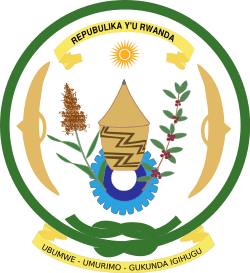Rwandan parliamentary election, 1957
 |
| This article is part of a series on the politics and government of Rwanda |
|
Government |
|
Judiciary |
|
United Nations in Rwanda |
Indirect parliamentary elections were held in Rwanda in 1957.
Electoral system
The Decree of 14 July 1952 by the Belgian authorities introduced an element of democracy to the Rwandan political system. A complicated electoral system was created, which involved seven stages of elections to eventually elect the national Superior Council (French: Conseil Superieur du Pays).[1] The system was modified from the 1953–54 elections with all men aged 18 or over able to vote for the Sub-Chiefdom Councils, as voting had previously been restricted to notables.[2]
| Council | Elected members | Ex officio members | Other members |
|---|---|---|---|
| Sub-Chiefdom Council | 5–10 members elected by all men aged 18 and over | Sub-chiefs | |
| Chiefdom Council | 10–18 members, 5–9 elected by sub-chiefs and 5–9 elected by notables | Chiefs | |
| Territorial Council | Sub-chiefs elected from amongst their own and notables elected by Chiefdom Councils | Chiefs | |
| Superior Council | 6 chiefs elected from their own number, 9 notables elected by Territorial Councils | King, presidents of the Territorial Councils | Up to 8 co-opted |
Results
The elections in the sub-chiefdoms were held in 1956, with the elections to the Chiefdom Councils Territorial Councils and the Superior Council following in 1957.[3]
| Council | Members | |||||||||||
|---|---|---|---|---|---|---|---|---|---|---|---|---|
| Hutus | Tutsis | Total | ||||||||||
| Elected chiefs |
Elected notables |
Co-opted | Elected chiefs |
Elected notables |
Ex officio | Co-opted | ||||||
| Sub-chiefdom councils | 0 | 2,261 | 0 | 0 | 1,292 | 603 | 0 | 4,160 | ||||
| Chiefdom councils | 0 | 107 | 0 | 298 | 245 | 54 | 0 | 704 | ||||
| Territorial councils | 0 | 21 | 0 | 46 | 71 | 46 | 0 | 184 | ||||
| Superior Council | 0 | 0 | 1 | 6 | 9 | 10 | 7 | 33 | ||||
| Source: Sternberger et al. | ||||||||||||
References
- ↑ Dolf Sternberger, Bernhard Vogel, Dieter Nohlen & Klaus Landfried (1978) Die Wahl der Parlamente: Band II: Afrika, Zweiter Halbband, p1699
- ↑ Sternberger et al., p1698
- ↑ Sternberger et al, p1725
This article is issued from
Wikipedia.
The text is licensed under Creative Commons - Attribution - Sharealike.
Additional terms may apply for the media files.